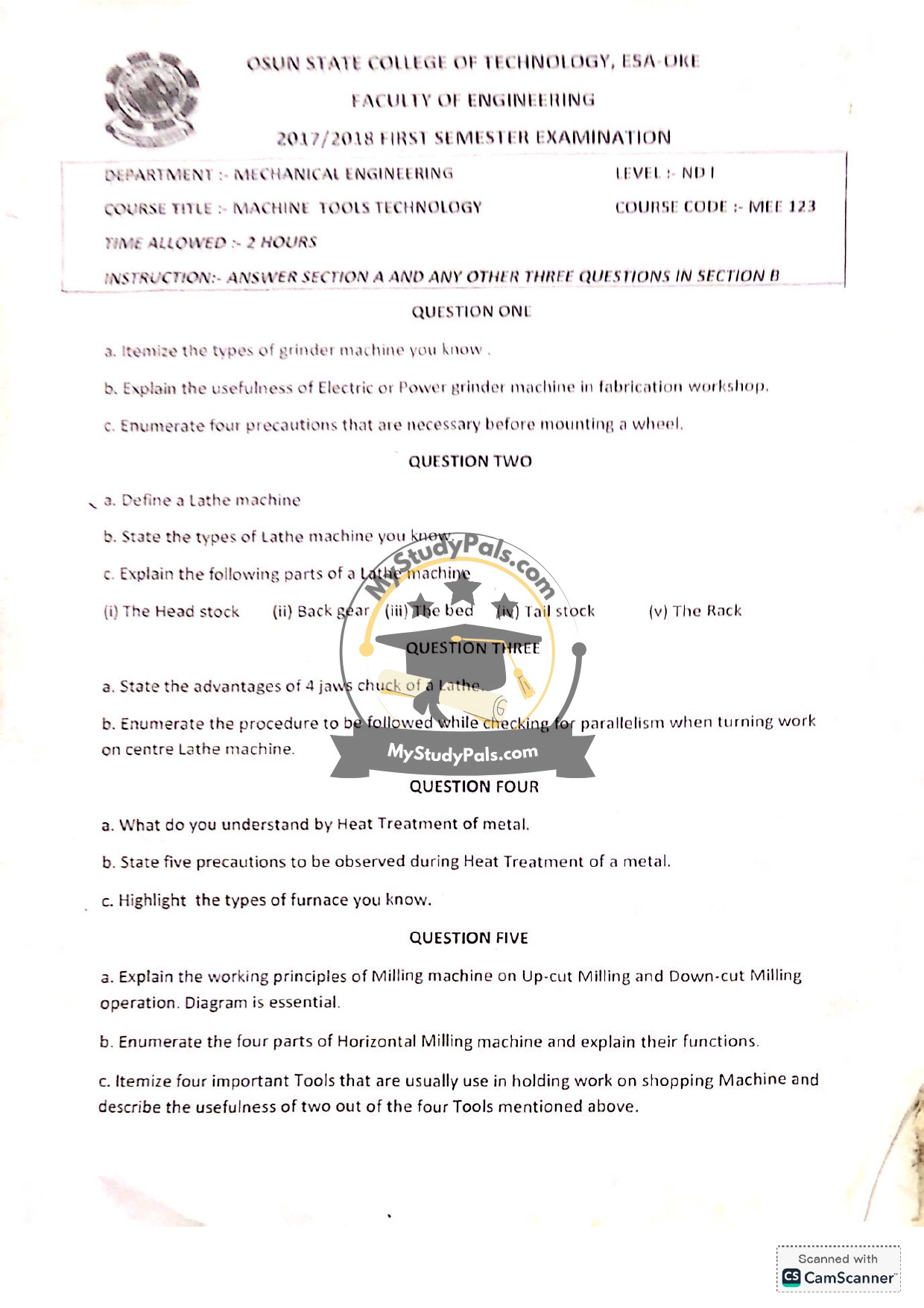ANWSER
—
Question 1:
a. Types of grinder machines:
– Bench grinder
– Pedestal grinder
– Surface grinder
– Cylindrical grinder
– Tool and cutter grinder
– Angle grinder
b. Usefulness of Electric/Power grinder machine in fabrication workshop:
– Used for grinding, shaping, and smoothing metal surfaces.
– Essential for sharpening tools and cutting edges.
– Removes excess material quickly and efficiently.
– Provides precision in finishing operations.
c. Precautions before mounting a wheel:
– Inspect the wheel for cracks or damage.
– Ensure the wheel speed rating matches the grinder’s speed.
– Use the correct flange and mounting hardware.
– Tighten the mounting nut securely but not excessively.
—
Question 2:
a. Definition of a Lathe machine:
A lathe machine is a tool that rotates a workpiece on its axis to perform operations such as cutting, sanding, knurling, drilling, or deformation with tools applied to the workpiece.
b. Types of Lathe machines:
– Engine lathe
– Turret lathe
– Capstan lathe
– Toolroom lathe
– CNC lathe
– Bench lathe
c. Explanation of parts:
(i) The Headstock: Houses the main spindle and gear mechanism to control the speed of the workpiece.
(ii) Back gear: Provides additional torque for low-speed operations.
(iii) The Bed: The base of the lathe that supports all other components and ensures alignment.
(iv) Tailstock: Supports the other end of the workpiece and can hold tools for drilling or centering.
(v) The Rack: A gear mechanism that moves the carriage along the bed.
—
Question 3:
a. Advantages of a 4-jaw chuck:
– Can hold irregularly shaped workpieces.
– Allows independent adjustment of each jaw for precise centering.
– Provides a stronger grip for heavier workpieces.
b. Procedure for checking parallelism:
– Mount the workpiece between centers or in a chuck.
– Use a dial indicator to measure the workpiece at multiple points along its length.
– Adjust the workpiece or tool position until the dial indicator shows consistent readings.
—
Question 4:
a. Heat Treatment of metal:
Heat treatment is a controlled process of heating and cooling metals to alter their physical and mechanical properties without changing their shape.
b. Precautions during Heat Treatment:
– Use appropriate protective gear to avoid burns.
– Ensure uniform heating to prevent warping.
– Follow precise temperature and cooling rates.
– Avoid overheating to prevent grain growth.
– Use a controlled atmosphere to prevent oxidation.
c. Types of furnace:
– Box furnace
– Pit furnace
– Salt bath furnace
– Induction furnace
– Muffle furnace
—
Question 5:
a. Working principles of Milling machine:
– Up-cut Milling: The cutter rotates against the direction of the workpiece feed, producing a smooth finish but requiring more power.
– Down-cut Milling: The cutter rotates in the same direction as the workpiece feed, reducing tool wear but potentially causing a rougher finish.
b. Parts of Horizontal Milling machine and their functions:
– Base: Supports the machine and absorbs vibrations.
– Column: Houses the motor and driving mechanism.
– Knee: Adjusts the vertical position of the workpiece.
– Table: Holds and moves the workpiece during milling.
c. Tools for holding work on a Milling machine:
– Vise
– Clamps
– Angle plates
– Fixtures
– Usefulness of two tools:
– Vise: Secures the workpiece firmly for precise operations.
– Clamps: Provide additional stability for irregularly shaped workpieces.
—


